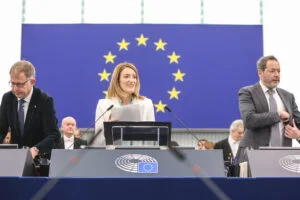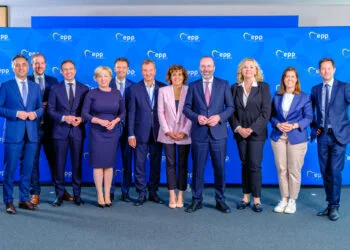Brussels – All eyes will be on the confirmation vote of the President of the European Commission, Ursula von der Leyen, but the first appointment of the inaugural session of the tenth legislature of the European Parliament will be another election for the presidency of the EU institution itself, in its new configuration of 720 MEPs after the European elections of June 6–9. Tuesday (July 16) at 10 a.m., the plenary session in Strasbourg will open with the vote to elect the successor to Roberta Metsola, who, barring any sensational last-minute surprises, is set to succeed herself at the helm of the European Parliament for at least another two and a half years.
 All the 720 MEPs who make up the Assembly participate in the election. To be elected to the presidency, the candidate or nominee must obtain an absolute majority of votes validly cast by secret ballot. Please note: not an absolute majority of the number of eligible voters. Their number would coincide only if all 720 members of the European Parliament participated in the vote and cast a valid vote (in this case, the election threshold is 361 votes). However, one must consider abstentions, blank ballots, and void ballots. In practical terms, they have the same value and go to lower the threshold required for election. Taking a practical example, if 30 members (out of 720) abstained and there were 20 blank ballots and 10 void ballots, there would remain 660 validly cast votes, and thus the candidate or nominee able to reach 331 votes (30 fewer than those required if everyone cast a valid vote) would be elected as President of the European Parliament.
All the 720 MEPs who make up the Assembly participate in the election. To be elected to the presidency, the candidate or nominee must obtain an absolute majority of votes validly cast by secret ballot. Please note: not an absolute majority of the number of eligible voters. Their number would coincide only if all 720 members of the European Parliament participated in the vote and cast a valid vote (in this case, the election threshold is 361 votes). However, one must consider abstentions, blank ballots, and void ballots. In practical terms, they have the same value and go to lower the threshold required for election. Taking a practical example, if 30 members (out of 720) abstained and there were 20 blank ballots and 10 void ballots, there would remain 660 validly cast votes, and thus the candidate or nominee able to reach 331 votes (30 fewer than those required if everyone cast a valid vote) would be elected as President of the European Parliament.
Outgoing President Metsola, the European People’s Party (EPP) family candidate, is currently the only candidate running and could be aiming for a resounding election by acclamation. As provided by Article 15 of the rules of procedure of the EU institution, if the number of nominations is equal to the number of seats to be filled (the same applies to vice-presidents and quaestors), the election may be held by acclamation, without recourse to a vote, unless one or more parliamentary groups—representing at least one-fifth of the Members (144)—request a secret ballot. In that case, the first of the re-elected outgoing vice presidents, Italy’s Pina Picierno (PD), will coordinate voting operations. The deadline for notification of the group’s constitution will be July 15. We must wait for that date to find out whether there will be challengers for Metsola: not so much from the old groups (Popular, Social Democrats, Liberals, Greens, Conservatives, and Left), but rather from the new far-right groups of Patriots for Europe (PfE) and Europe of Sovereign Nations (ESN).

Only candidates formally submitted by the respective parliamentary groups may be voted. If no elected person emerges at the end of the first round of voting, the second round and a possible third round will be held. Theoretically, new candidates can be submitted at the end of each voting round. If there is still no majority after three ballots, a fourth and final round will be held: a runoff between the two candidates who garnered the most votes in the third round. The one with the most preferences wins, and the oldest candidate is elected in case of a tie.
If there is no acclamation of Metsola, the first round will be at 10 a.m., and if necessary, subsequent rounds will occur: the second at 12:30 p.m., the third at 3 p.m., and the fourth—and in any case last—at 5 p.m. On the other hand, the election of the 14 vice presidents of the European Parliament will begin on Tuesday afternoon, just after the appointment of the highest office of the EU institution. Should the President be elected already in the morning, voting for the vice presidents will begin at 12:30, and two more possible rounds may take place (from 3 p.m.). Should a third or fourth ballot be needed for the presidency, voting for the vice presidency will be postponed until late afternoon but will, in any case, be concluded by the end of the evening.
English version by the Translation Service of Withub
![Pina Picierno [archivio]](https://www.eunews.it/wp-content/uploads/2021/12/20211213_EP-123177C_STP_431-scaled.jpg.webp)


![La presidente del Parlamento europeo, Roberta Metsola, interviene alla sessione plenaria del Cese [Bruxelles, 10 luglio 2024]](https://www.eunews.it/wp-content/uploads/2024/07/metsola-240710-350x250.jpeg.webp)





